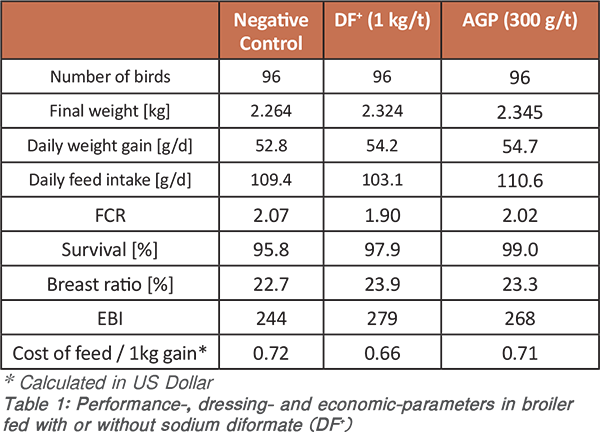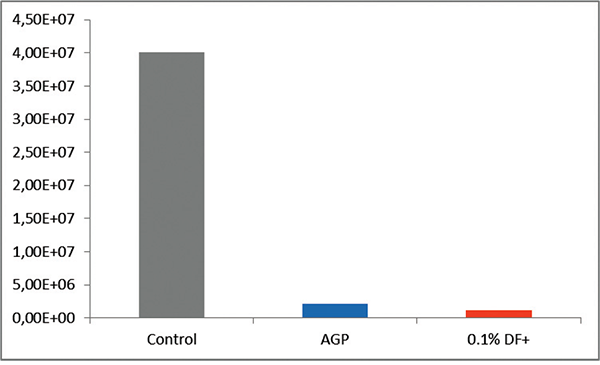Dietary Sodium Diformate (Acidomix DF+) in Broiler Nutrition: A New Approach for Sustainable Poultry Production

Christian Lückstädt, ADDCON, Bonn, Germany
Sarah Mellor, Independent Writer, Weinheim, Germany
Evidence of the development of antibiotic resistant strains of bacteria that are pathogenic to humans has mounted over recent decades; and the practice of using sub-therapeutic levels of antibiotics as growth promoters (AGP) in livestock production has been heavily implicated in this resistance. Worldwide, this connection has led to the erosion of consumer trust in agricultural practices that rely on this valuable medical resource. Increasingly, legislation is limiting their use. The latest news from Europe is that Denmark now imposes even stricter laws on antimicrobial use. This updated agreement, ratified by the Danish parliament, is an extension of previous agreements on animal welfare and the reduction of excessive antimicrobial use. “Stricter rules for the use of antimicrobials are part of strengthening the One-Health-perspective where animal health and human health are closely connected” (Ministry of Food, Agriculture and Fisheries, Denmark, 2012).
The shift from AGP to alternatives that began in Europe has spread rapidly, as exporting countries have had no choice but to comply. A number of alternative feed additives have been investigated. Among the new, tested compounds are acidifiers. These supplements include organic acids and their salts, like diformates. Potassium diformate, for instance, the potassium double-salt of formic acid, rapidly gained formal approval as the first legal alternative for in-feed antibiotics in Europe.
Formic acid and its salts are well known to improve productivity, acting against pathogens, which decreases the pressure on the animal’s immune system. Thus, more nutrients will be available for productive functions such as growth or laying; whilst acting on the feed matrix to provide optimal conditions for digestive enzymes, particularly pepsin, releasing more nutrients from the feed. The double sodium salt of formic acid, while having the same antimicrobial properties as formic acid, has become more commonly used in poultry production, as it is easier to handle and does not negatively affect palatability, as can the pure acid.
Thus, several trials have been carried out in order to demonstrate the effectiveness of sodium diformate (Acidomix DF+, Venky’s) under various conditions world-wide.
First reports on the effect of sodium diformate in poultry nutrition appeared in 2009 (Lückstädt & Theobald) on the effect against Salmonella, Campylobacter and further gut microbiota. Later that year a paper entitled “Reducing broiler feed costs with diformate” was published by Swick & Lückstädt. Further, reports from Lückstädt., Eidelsburger and Theobald (2010) as well as Lückstädt & Theobald (2010) concentrated on the use of diformate in broilers at various dosages; and against positive and negative controls. The effect of the additive in turkey nutrition was confirmed in 2011 by Glawatz, Meyer and Lückstädt. Inclusion of the double salt into layer diets proved beneficial, especially on egg quality parameters and number of pathogens (Kühlmann et al., 2012). Finally, the anti-Salmonella effect of sodium diformate was confirmed by DEFRA in 2011/12.
The benefits of incorporating sodium diformate in broiler diets were as well tested recently under tropical conditions in a trial conducted at the research farm of the University of Agriculture and Forestry in Ho Chi Minh City, Vietnam. The acidifier was tested (0.1% DF+) in a commercial broiler diet, against the same diet containing either no acidifier (control group) or an antibiotic growth promoter (AGP: BMD-10 at 300g/t of feed). Feed and water were available ad libitum. The effects of DF+ on performance parameters of poultry (livestock viability, live weight, feed consumption and feed conversion), on dressing (breast meat ratio), as well as litter quality (water content, bacterial load) were examined. 288 day old birds (Cobb 500) were randomly selected and divided into 3 treatment groups with 96 chicks each. The diets were fed for 42 days. Performance data were measured at the end of the trial (Tab. 1).

Overall performance in the groups with DF+ was increased, even when compared to the AGP-group. The addition of 0.1% sodium diformate under the circumstances of the trial resulted in an increase of 2.6% in weight gain, while the feed conversion rate was improved by 8.2%, compared to the negative control. Furthermore, this DF+- inclusion was best according to the broiler index as well as being the most cost effective. Furthermore, birds fed with Acidomix DF+ had a numerical improvement when dressed. The breast meat ratio increased by more than 5% if compared to the negative control, while the improvement compared the AGP-group was still nearly 3%. One could speculate that this was caused by the improved protein digestibility, which is often reported in conjunction with the use of dietary acidifier.

Finally, the faecal quality and content of birds was examined. It could be stated that the litter quality – based on the moisture content, was significantly (P<0.05) improved in birds fed DF+ (tested against the negative control). Moisture content in the faecal matter was reduced by 7% (in the 0.1% DF+-dosage); while the AGP-group had only a reduction of 4% in the moisture content of faecal matter (moisture content of control litter was 57.2%). In conjunction with the improved quality of the litter is also the significantly reduced (P<0.05) level of E.coli in the faeces (Fig. 1), which is measured as MPN (Most Probable Number). If looked at the reduction rate, one could say that the use of dietary sodium diformate reduces the E.coli load in faeces by almost 97%!
In a further study conducted at the All-Russian Scientific Research and Technological Institute of Poultry Breeding (VNITIP) in Moscow the effects of Acidomix DF+ on performance parameters of poultry breeding (livestock viability, live weight, feed consumption, feed conversion ratio and digestibility of nutrients) were examined.
The product was tested at a dosage of 0.1%. For comparison of alternative compounds an acid blend, consisting of mainly formic acid and lactic acid, was employed at the dosage of 0.3%. A negative control group received the basic diet without supplement. Each of the three treatment groups, 0.1% diformate, 0.3% acid-blend and negative control, consisted of 35 1- to 38-day-old birds. On day 38 after hatching livestock viability, live weight and feed conversion ratio were determined (Table 2).

There have been no reported mortalities during the study, which shows the quality of the trial location. Despite such a good hygienic status, addition of diformate was still found to enhance individual live weight. By the end of the experiment (day 38) broiler reached a weight gain surplus of 5.6% compared to the control group. Feed conversion ratio was also clearly improved by the use of sodium diformate (by 7.1% compared to negative control). In comparison, the triple acid-blend dosage led only to a reduction in feed conversion by 5.2%. The present findings lead to the conclusion that addition of DF+ considerably improves performance parameters of poultry by increasing live weight and improving feed conversion ratio, compared against a negative and a positive control.
Numerous reports have demonstrated how including sodium diformate in broiler diets has beneficial effects on performance by lowering bacterial pathogen load and improving nutrient digestibility, as reported above. These benefits are turned into economic returns, despite the perceived increase in feed cost of using additives. It is therefore recommended for the poultry producers to include dietary acidifiers, like Acidomix DF+, into their broiler diets.
